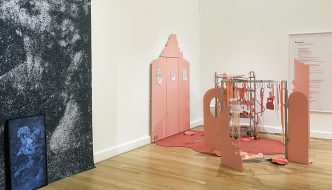 Passing along the highway to hell, we find ourselves in the midst of a huge tailback as rubber neckers continue to gawp at the flaming mangled wreck at the side of the road. This was, of course, the US presidential election, a huge and important event with global implications that I want to quickly pass by.
Passing along the highway to hell, we find ourselves in the midst of a huge tailback as rubber neckers continue to gawp at the flaming mangled wreck at the side of the road. This was, of course, the US presidential election, a huge and important event with global implications that I want to quickly pass by.
Instead, I thought perhaps now is a good time to talk about the overt political intents of artists.
Now this is only a short text and by no means gospel, but still, I feel that it is only right to begin this by saying: I enjoy coming face to face with politics within artworks. Equally, I should interject that, generally, I really hate the conversation fostered by politics in contemporary art.
This recently became all too apparent as I stood watching a video work this past week. Hyper-saturated with colour, fast paced and loud, it screamed, (not literally) “Capitalism in overdrive is killing us all.” ‘Aye,’ I thought, ‘Bad that…’
And I’m being sincere, but what left me cold is that I don’t understand why I am being told this—I already think it. To me, this is a kind of ‘down the pub conversation’ I have with particular friends who I know agree and, equally, will tell me their friends think the same. Which already covers most of the demographic that will visit the exhibition featuring the work mentioned. And each viewer of the video will think, ‘Aye, I thought that too.’
What interests me, however, is that the ‘fat cats’, bankers, and yuppies the video takes particular aim at were not those visiting the exhibition—and honestly, I don’t think they will be either. As they (sorry to generalise) and a general public are not the people who are being encouraged to visit. So then, who are we really trying to talk to? Actually. Scrap that. We aren’t actually trying to talk at all.
Instead what appears to have become the dominant trend in terms of political intent by artists is (often) to use a political standpoint as nothing more than an aesthetic trait. Opting to use politics as a smokescreen device to instead create a self-assuring and masturbatory situation where members of the ‘art community’ can come together and feel as one. United by a collective aim of social consciousness with ‘feel-good’ leftist ideologies.
Yet to momentarily stand back, the scene appears little more than the seagulls from Pixar’s Finding Nemo, with each person screaming ‘mine, mine, mine,’ in an attempt to let everybody (including ourselves) know where we want to be positioned and within which denomination.
These statements also largely go unheard, as we cry out and demonise particular views, positions, and policies (namely from the right) to an audience based upon the left. Finding rarely through artworks, conversation, or in written criticism that members of the art community come face to face with a differing political ideal through the content of an unorthodox position taken by an artist.
But is this even really surprising? Most artworks are shown in institutions or art spaces that ooze social liberalism and optimistic, progressive viewpoints. Embracing the alternative and standing steadfast against exploitation and the like. Yet these places, through the continued enablement of a conservative government, have relished the opportunity to utilise exploitative traits such as zero-hour contracts and free or underpaid labour while many of the back-of-house staff often profit from generous benefits and flexible contracts.
By no means do I hope to suggest that everyone should be making work about the ‘art world’ (yawn!), but instead I’m hoping to allude to the (often) hypocritical attitudes presented by artists who are happy to critique the exploitative traits witnessed within society but appear to turn a blind eye to those operating within their own homes. Leading to the question of why this is so prevalent.
Perhaps it could be put down to the age-old topics of ‘pluralism’ or even ‘neo-liberalism.’ Two hot-issues everyone loves to get their teeth into given the opportunity. But perhaps the reality is actually much more saddening. And that is that we are lazy and self-preserving.
Institutional critique is rife and can be exciting, insightful, and demanding of viewers but it has, with no shadow of a doubt, become merely an aesthetic haze employed by art institutions and art spaces to demonstrate a seeming willingness to comply with self-reflection and self-critique while producing little or minimal change.
It is then the artists who comply and so easily fall in line with adopted policy who end up becoming merely baubles on the tree, enabling a situation through pseudo-political works which merely scratch the surface for fear of sparking repercussions, being labelled an outsider or, worse, a traitor to the art community.
There are countless subjects and topics that could genuinely create some form of divide and discussion within art. Dealing with the real and impactful, nitty-gritty details that do divide those within the art community, such as:
– The rising intake of international students at art schools across the UK due to the higher fees they bring.
– The continuing lack of opportunities (and mobility) for artists who are not afforded the chances that those who come from wealthier backgrounds are granted—internships, opportunities to be artist’s assistants, low paid ‘entry positions’ in arts organisations.
– The lack of ‘meaty’ criticism of exhibitions, works, and institutions.
Just think: How can the many established outlets for art criticism and discussion really be on point and honest when these very establishments generate income from advertising the shows they are purportedly ‘reviewing’? This is, however, none too different from the situation we find artists in at the moment. Just replacing the outlets and advertisements for institutions and artists.
We know that there are still active and deep-rooted social issues that need to be tackled but let’s look at their specifics, or at least approach them in a way aimed to provoke discussion. Because if we are making the party invite only, then it’s time we change the conversation. Otherwise, I think it’s time to go home.
Filed under: Art & Photography, Politics
Tagged with: Alt-Right, Art Criticism, artists, Capitalism, Establishment, Hypocrisy, Institutions, Left-Wing, Right-Wing



Comments